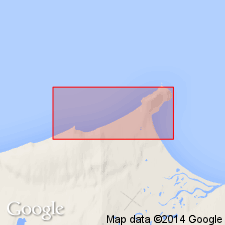
- Usage in publication:
-
- Deceit Formation
- Modifications:
-
- Original reference
- Dominant lithology:
-
- Limestone
- Dolomite
- Shale
- AAPG geologic province:
-
- Selawik Lowland basin
Summary:
Pg. 347-348, fig. 1. See also H.T. Mullins and H.E. Cook, 1986, Carbonate apron models, IN Sed. Geol. Deceit Formation. Three sections related by fossil and facies data but complicated by faulting and poor exposure. Upper part severely brecciated. Includes (descending) 60 m thick dolomite and limestone member of Silurian age (inner apron); >185 m thick limestone member of Silurian age (inner to outer apron); and >70 m thick shale and limestone (basin plain) of Ordovician to Silurian age. Contacts unknown. May correlate with platform carbonates in York Mountains and in Baird Mountains. Age is Ordovician to Silurian.
Type section (composite): Kotzebue Sound as well as at Cape Deceit. Named from Cape Deceit, west-central AK.
Source: GNC index card files (USGS-Menlo).
For more information, please contact Nancy Stamm, Geologic Names Committee Secretary.
Asterisk (*) indicates published by U.S. Geological Survey authors.
"No current usage" (†) implies that a name has been abandoned or has fallen into disuse. Former usage and, if known, replacement name given in parentheses ( ).
Slash (/) indicates name conflicts with nomenclatural guidelines (CSN, 1933; ACSN, 1961, 1970; NACSN, 1983, 2005, 2021). May be explained within brackets ([ ]).

